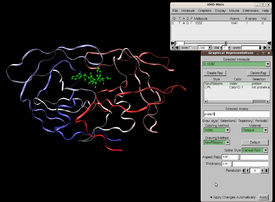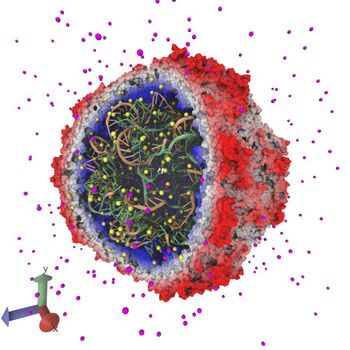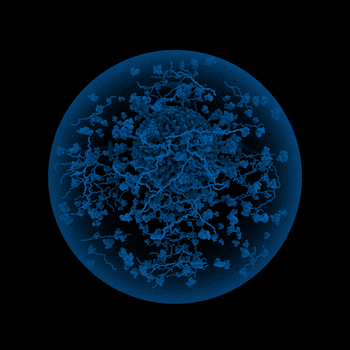Software:Visual Molecular Dynamics
 Screenshot of VMD 1.8.3. | |
| Original author(s) | William Humphrey, Andrew Dalke, Klaus Schulten, John Stone |
|---|---|
| Developer(s) | University of Illinois at Urbana–Champaign |
| Initial release | July 4, 1995 |
| Stable release | 1.9.4 alpha 55
/ October 2021 |
| Written in | C |
| Operating system | macOS, Unix, Windows |
| Available in | English |
| Type | Molecular modelling |
| License | Distribution-specific[1] |
| Website | www |
Visual Molecular Dynamics (VMD) is a molecular modelling and visualization computer program.[2] VMD is developed mainly as a tool to view and analyze the results of molecular dynamics simulations. It also includes tools for working with volumetric data, sequence data, and arbitrary graphics objects. Molecular scenes can be exported to external rendering tools such as POV-Ray, RenderMan, Tachyon, Virtual Reality Modeling Language (VRML), and many others. Users can run their own Tcl and Python scripts within VMD as it includes embedded Tcl and Python interpreters. VMD runs on Unix, Apple Mac macOS, and Microsoft Windows.[3] VMD is available to non-commercial users under a distribution-specific license which permits both use of the program and modification of its source code, at no charge.[4]
History

VMD has been developed under the aegis of principal investigator Klaus Schulten in the Theoretical and Computational Biophysics group at the Beckman Institute for Advanced Science and Technology, University of Illinois at Urbana–Champaign.[5][6] A precursor program, called VRChem, was developed in 1992 by Mike Krogh, William Humphrey, and Rick Kufrin. The initial version of VMD was written by William Humphrey, Andrew Dalke, Ken Hamer, Jon Leech, and James Phillips.[7] It was released in 1995.[7][8] The earliest versions of VMD were developed for Silicon Graphics workstations and could also run in a cave automatic virtual environment (CAVE) and communicate with a Nanoscale Molecular Dynamics (NAMD) simulation.[2] VMD was further developed by A. Dalke, W. Humphrey, J. Ulrich in 1995–1996, followed by Sergei Izrailev and J. Stone during 1997–1998. In 1998, John Stone became the main VMD developer, porting VMD to many other Unix operating systems and completing the first full-featured OpenGL version.[9] The first version of VMD for the Microsoft Windows platform was released in 1999.[10] In 2001, Justin Gullingsrud, and Paul Grayson, and John Stone added support for haptic feedback devices and further developing the interface between VMD and NAMD for performing interactive molecular dynamics simulations.[11][12] In subsequent developments, Jordi Cohen, Gullingsrud, and Stone entirely rewrote the graphical user interfaces, added built-in support for display and processing of volumetric data,[13] and the use of OpenGL Shading Language.[14]
Interprocess communication
VMD can communicate with other programs via Tcl/Tk.[3] This communication allows the development of several external plugins that works together with VMD. These plugins increases the set of features and tools of VMD making it one of the most used software in computational chemistry, biology, and biochemistry.
Here is a list of some VMD plugins developed using Tcl/Tk:
- Delphi Force — electrostatic force calculation and visualization[15]
- Pathways Plugin — identify dominant electron transfer pathways and estimate donor-to-acceptor electronic tunneling
- Check Sidechains Plugin — checks and helps select best orientation and protonation state for Asn, Gln, and His side chains
- MultiMSMS Plugin — caches MSMS calculations to speedup the animation of a sequence of frames
- Interactive Essential Dynamics — Interactive visualization of essential dynamics
- Mead Ionize — Improved version of autoionize for highly charged systems
- Andriy Anishkin's VMD Scripts — Many useful VMD scripts for visualization and analysis
- RMSD Trajectory Tool — Development version of RMSD plugin for trajectories
- Clustering Tool — Visualize clusters of conformations of a structure
- iTrajComp — interactive Trajectory Comparison tool
- Swap — Atomic coordinate swapping for improved RMSD alignment
- Intervor — Protein-Protein interface extraction and display
- SurfVol — Measure surface area and volume of proteins[16]
- vmdICE — Plugin for computing RMSD, RMSF, SASA, and other time-varying quantities[17]
- molUP - A VMD plugin to handle QM and ONIOM calculations using the gaussian software[18]
- VMD Store - A VMD extensions that helps users to discover, install, and update other VMD plugins.[19]
See also
References
- ↑ VMD license
- ↑ 2.0 2.1 Humphrey, William; Dalke, Andrew; Schulten, Klaus (February 1996). "VMD: Visual molecular dynamics". Journal of Molecular Graphics 14 (1): 33–38. doi:10.1016/0263-7855(96)00018-5. PMID 8744570.
- ↑ 3.0 3.1 "VMD User's Guide Version 1.9.1". NIH Resource for Macromolecular Modeling and Bioinformatics. http://web.mit.edu/vmd_v1.9.1/ug.pdf.
- ↑ "VMD License". NIH Center for Macromolecular Modeling & Bioinformatics, University of Illinois at Urbana–Champaign. http://www.ks.uiuc.edu/Research/vmd/current/LICENSE.html.
- ↑ Schulten, Klaus. "Department of Health and Human Services Public Health Service National Institutes of Health NIH Resource Biomedical Research Technology Program Annual Progress Report, Grant Number P41 RR05969". http://www.ks.uiuc.edu/Publications/Reports/nihreport/NIHreport1996.pdf.
- ↑ Schulten, Klaus J.. "Department of Health and Human Services Public Health Service National Institutes of Health National Center for Research Resources Biomedical Technology Area Annual Progress Report (8/1/10 – 7/31/11), Grant Number P41RR005969". http://www.ks.uiuc.edu/Publications/Reports/nihreport/NIHreport2011.pdf.
- ↑ 7.0 7.1 "VMD Release History". NIH Center for Macromolecular Modeling & Bioinformatics, University of Illinois at Urbana–Champaign. http://www.ks.uiuc.edu/Research/vmd/allversions/release_history.html.
- ↑ Bishop, Tom Connor (July 4, 1995). "Announcing the Program VMD, Version 1.0". CCL.Net. http://www.ccl.net/cgi-bin/ccl/message.cgi?1995+07+04+003.
- ↑ "VMD 1.3". NIH Center for Macromolecular Modeling & Bioinformatics, University of Illinois at Urbana–Champaign. http://www.ks.uiuc.edu/Research/vmd/vmd-1.3/devel.html.
- ↑ "VMD 1.4". NIH Center for Macromolecular Modeling & Bioinformatics, University of Illinois at Urbana–Champaign. http://www.ks.uiuc.edu/Research/vmd/vmd-1.4/devel.html.
- ↑ Stone, John E.; Gullingsrud, Justin; Grayson, Paul; Schulten, Klaus (2001). "A system for interactive molecular dynamics simulation". 2001 ACM Symposium on Interactive 3D Graphics. New York, NY, USA: ACM. pp. 191–194. http://www.ks.uiuc.edu/Publications/Papers/paper.cgi?tbcode=STON2001.
- ↑ Dreher, Matthieu et al. (2013). "Interactive Molecular Dynamics: Scaling up to Large Systems". International Conference on Computational Science, ICCS 2013, Jun 2013, Barcelone, Spain. New York, NY, USA: Elsevier. https://hal.inria.fr/hal-00809024/file/main.pdf.
- ↑ "VMD 1.8". NIH Center for Macromolecular Modeling & Bioinformatics, University of Illinois at Urbana–Champaign. http://www.ks.uiuc.edu/Research/vmd/vmd-1.8/devel.html.
- ↑ "VMD 1.8.7". NIH Center for Macromolecular Modeling & Bioinformatics, University of Illinois at Urbana–Champaign. http://www.ks.uiuc.edu/Research/vmd/vmd-1.8.7/winrelnotes.html.
- ↑ Li, Lin; Jia, Zhe; Peng, Yunhui; Chakravorty, Arghya; Sun, Lexuan; Alexov, Emil (2017-11-15). "DelPhiForce web server: electrostatic forces and energy calculations and visualization" (in en). Bioinformatics 33 (22): 3661–3663. doi:10.1093/bioinformatics/btx495. ISSN 1367-4803. PMID 29036596.
- ↑ Ribeiro, João V.; Tamames, Juan A. C.; Cerqueira, Nuno M. F. S. A.; Fernandes, Pedro A.; Ramos, Maria J. (2013-12-01). "Volarea – A Bioinformatics Tool to Calculate the Surface Area and the Volume of Molecular Systems" (in en). Chemical Biology & Drug Design 82 (6): 743–755. doi:10.1111/cbdd.12197. ISSN 1747-0285. PMID 24164915.
- ↑ Knapp, Bernhard; Lederer, Nadja; Omasits, Ulrich; Schreiner, Wolfgang (2010-12-01). "vmdICE: A plug-in for rapid evaluation of molecular dynamics simulations using VMD" (in en). Journal of Computational Chemistry 31 (16): 2868–2873. doi:10.1002/jcc.21581. ISSN 1096-987X. PMID 20928849.
- ↑ Fernandes, Henrique; Ramos, Maria João; Cerqueira, Nuno M. F. S. A. (2018). "molUP: A VMD plugin to handle QM and ONIOM calculations using the gaussian software". Journal of Computational Chemistry 39 (19): 1344–1353. doi:10.1002/jcc.25189. PMID 29464735.
- ↑ Fernandes, Henrique S.; Sousa, Sérgio F.; Cerqueira, Nuno M. F. S. A. (2019-11-25). "VMD Store–A VMD Plugin to Browse, Discover, and Install VMD Extensions" (in en). Journal of Chemical Information and Modeling 59 (11): 4519–4523. doi:10.1021/acs.jcim.9b00739. ISSN 1549-9596. PMID 31682440. https://pubs.acs.org/doi/abs/10.1021/acs.jcim.9b00739.
External links
 |


